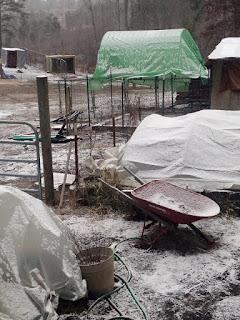Garden Maintenance Checklist for February
January and February are my 2 least favorite months because for us in the southeast they are usually the coldest and most likely to get some snow and ice. Which I also hate!
I'm a spring, summer and fall girl all the way! Gardening books, planners and seed catalogs help but there is no real substitute for getting in the dirt and sunshine!
At least in February things pick up for seed starting! There are only a few things I can start in January but this month I get to start early tomatoes, ground cherries and other things I can put out early in wall o' waters!!
Let the fun begin... if you missed Januarys checklist you can get it here Garden Maintenance Checklist: January
My February Garden Checklist
- Prune fruit trees, blueberries and propagate raspberries if you grow them.
- Prepare beds for carrots, spring greens, onions, broccoli, and potatoes
- Weed perennials such as asparagus, walking onions and strawberries and give some compost.
- Sow inside at seed starting station or in the greenhouse: cabbage, cauliflower, broccoli, kohlrabi, hot and sweet peppers, Asian greens, celery, lettuces, leeks. I also start tomatoes, cucumbers and anything I plan to plant in a wall o'water.
- Outside you can plant arugula, spinach, and radishes.
- When the daffodils start to come up or the forsythia starts to bloom I plant my snow peas (in a low tunnel or under a row cover. I also plant cold-hardy greens, carrots and fava beans outside at this time.
- If you started spinach, onions or other hardy greens last month you can transplant outside them after hardening off.
Isn't it exciting? There is nothing as wonderful as a garden!
If you've not got your garden planned yet you can download a copy of this PDF to help with rotation planting based on Nutrient Needs of Vegetables
Keep in mind this checklist is best for those in Zone 7a and 7b. Your zone may require a later start to some of these seeds.
Also on the Farm
Our Livestock and Farm Days in the Cold
Luckily we do not raise any livestock that cannot handle cold weather on their own anymore!
Though cold weather does take its toll on us as we have to go out and care for the livestock every day no matter the weather. Still, Some require a bit more time outside than others.
Like my husbands Meishan pigs, since they don't have access to the ponds or creeks the Bald Man has to water and of course, feed every day. But they do absolutely fine in the cold weather with simple 3 sided pallet sheds! So no worries with them!
Never heard of the best homestead hog ever? You can check out a bit more about them Wikipedia_Meishan Pig and the Meishan Articles
My Equine actually really like the cold, especially the horses! Yes, Donkeys are desert animals but healthy donkeys grow amazing thick coats for the winter and rarely go in the barn even if it snows.
In fact some of them grow hair and an undercoat that I have actually spun into art yarn! Spinning art yarn is one of my favorite ways to spend a cold day inside plus gives me more to sell in my etsy store for extra cash (to buy more miniature horses and seeds 🤣)
The Donkeys do hide in the barn for icy rain and wind though, unlike the horses who stand outside in any weather!
Obviously, they can handle it but Rain Rot can and does happen so here is a PDF printable home remedy for Rain Rot if your donkeys or horses need it Equine Rain Rot Remedy
My equine have access to creeks and ponds that do not freeze for water and the hay stations my husband build save me from carrying hay flakes to everyone everyday!
Making my winter chores very minimum! Most days I just walk down to the barn give them a treat and hug and get back in the warm house!
Endless natural water supply and hay (or pasture) for days is the best way to raise horses and donkeys for me. Anything else would make them to high input and I would fall behind on the gardens. As I did with higher maintenance livestock in the past. Time management and saving time is SO important when you're trying to homestead. As I found out the hard way!
You can check out this post for making DIY Hay Feeder
It also works really well for sheep...most goats, not so much 🤣🤣
Though the Angora goats did well with it.
I hope you're keeping warm and cozy in the brutal cold that's hit the USA this winter!!
Just get out those seeds and let the spring dreams take over for a while!
Saturday the warmth came out for a few hours and I gladly took advantage and hooked up Stormy for a drive around the lower pasture.
Till next time... May you have many Homestead Blessings and Bountiful Gardens 💚
**ALL photos you see are from my actual Homestead. I do not need to use purchased stock photos. What you see on my blog is REAL!







No comments:
Post a Comment